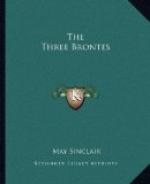And they are of that immortality which is the spirit of place—the spirit that, more than all spirits, inspired Emily Bronte. Two of Charlotte’s books, The Professor and Villette, might have been written away from Haworth; Emily’s owes much of its outward character to the moors, where it was brought forth. Not even Charlotte could paint, could suggest scenes like Emily Bronte. There is nobody to compare with her but Thomas Hardy; and even he has to labour more, to put in more strokes to achieve his effect. In four lines she gives the storm, the cold and savage foreground, and the distance of the Heights: “One may guess the power of the north wind blowing over the edge, by the excessive slant of a few stunted firs at the end of the house; and by a range of gaunt thorns, all stretching their limbs one way, as if craving alms of the sun.”
See the finish of this landscape, framed in a window: “They sat together in a window whose lattice lay back against the wall, and displayed, beyond the garden trees and the wild green park, the valley of Gimmerton, with a long line of mist winding nearly to its top (for very soon after you pass the chapel, as you may have noticed, the sough that runs from the marshes joins a beck which follows the bend of the glen). Wuthering Heights rose above this silvery vapour; but our old house was invisible; it rather dips down on the other side.”
In six lines she can paint sound, and distance, and scenery, and the turn of the seasons, and the two magics of two atmospheres. “Gimmerton chapel bells were still ringing; and the full, mellow flow of the beck in the valley came soothingly on the ear. It was a sweet substitute for the yet absent murmur of the summer foliage, which drowned that music about the Grange when the trees were in leaf. At Wuthering Heights it always sounded on quiet days following a great thaw or a season of steady rain.”
That music is the prelude to Heathcliff’s return, and to the passionate scene that ends in Catherine’s death.
And nothing could be more vivid, more concrete, than Emily Bronte’s method. Time is marked as a shepherd on the moors might mark it, by the movement of the sun, the moon, and the stars; by weather, and the passage of the seasons. Passions, emotions, are always presented in bodily symbols, by means of the bodily acts and violences they inspire. The passing of the invisible is made known in the same manner. And the visible world moves and shines and darkens with an absolute illusion of reality. Here is a road seen between sunset and moonrise: “... all that remained of day was a beamless amber light along the west: but I could see every pebble on the path, and every blade of grass, by the light of that splendid moon”.




